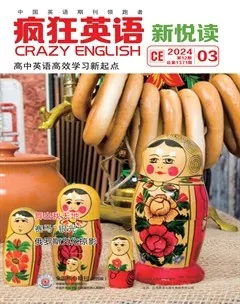Ancient Chinese wooden slips reveal celestial secrets干支木牍,揭示天文秘密
2024-05-14孙启禄
孙启禄

1 A set of ancient Chinesewooden slips, also known as mudu,has been recently discovered inSouthwest China's Chongqing Municipalityrecently. Featuring charactersrelated to the ancient Chinese astronomicalcalendar, the wooden slips are the first ever discovered in the country to revealcelestial secrets.
2 The set includes a total of 23 single wooden slips. Wooden slips like these, alongwith Chinese bamboo slips, or jiandu, were the earliest Chinese documents featuring words,and such an invention was also the most important form of early Chinese books.
3 On each“ page”, archaeologists were able to find characters written in ink relating tothe Chinese Tiangan Dizhi, or the Ten Heavenly Stems and 12 Earthly Branches, anancient astronomical calendar system involving 10 Chinese characters used as ordinals (序数) and another 12 characters used to divide a day into 12 twohourperiods. For example,wu (noon) refers to the time from 11 am to 1 pm. This wood slip calendar, which is still in aperfectly good condition, was discovered in a Western Han Dynasty tomb.
4 Despite its purpose being unknown, Sichuan archaeologist Yu Pei'er explained thatthe discovery might be closely “connected to the tomb owner's profession and beliefs”.“Wooden and bamboo slips are often found in ancient Chinese tombs, but the astronomicalcontents of the findings inspire us researchers to further investigate the specific burial customsof the area,” Yu remarked.
5 The wooden slips were discovered in the Guankou No. 1 Western Han Tomb locatedin the Wulong District of Chongqing Municipality. According to the informationinscribed (刻) on the slips, the tomb dates back to 193 BC, making it one of the oldestWestern Han Dynasty tombs ever discovered.
6“ This is the first time that we've found a tomb with a clear dating that puts itduring the Western Han period in China,”an archaeologist said, adding that the tombis also the best preserved wooden?chambered tomb ever found in Southwest China.
Reading Check
1. What is the significance of the characters found on the wooden slips?
A. They detail the personal life of the tomb owner.
B. They record ancient Chinese herbal medicine recipes.
C. They relate to the ancient Chinese astronomical calendar system.
D. They are instructions on traditional Chinese ceremonies.
2. Which of the following was also served as early Chinese documentation?
A. Stone tablets. B. Chinese bamboo slips.
C. Silk manuscripts. D. Clay tablets.
3. What aspect of the wooden slips discovery interested the researchers?
A. The potential connection to the tomb owners profession and beliefs.
B. Their detailed accounts of daily life during the Western Han Dynasty.
C. The artistry of the characters written on the slips.
D. The materials the slips were made from.
4. What can be known about the tomb where the wooden slips were found?
A. It contains the remains of a famous historical figure.
B. It is the largest tomb from the Western Han period ever discovered.
C. It is one of the oldest and best preserved Western Han Dynasty tombs found in the region.
D. It features the most intricate carvings and designs from that era.
语篇解码
What:本文的主题语境为人与社会,属于历史和传统的范畴。文章主要介绍了在重庆市发现的一组古代木牍,并强调了它们的独特性和重要性。本文共分为6个段落。第1、2、3段介绍了古代汉字木牍的发现情况并对木牍进行描述;第4段介绍了专家对木牍的解读;第5段指出这些木牍的发现地址及墓葬的起源;第6段介绍了木牍被发现的意义。
Why:这篇文章旨在向读者介绍木牍的发现及其意义。这是迄今为止发现的中国首次揭示天文学秘密的木牍,为我们了解古代中国天文学提供了宝贵的信息。同时,这些木牍也突显了木牍这种古代书写形式的重要性——它们是最早的汉字记录形式之一,对于记录和研究古代中国历史和文化具有重要价值。文章让我们对中国古代历史、文化和天文学有所了解,也为我们揭示了古代人們的思考方式。
How:本文是一篇新闻报道。新闻报道的时态以一般过去时为主,人称多用第三人称,通常包括何时(when)、何地(where)、何事(what)、何因(why)、何人(who)等要素。本文的词块主要与历史相关。
语言学习
Ⅰ. 语料荟萃
a set of 一套
be related to 与……有关
astronomical calendar 天文历法
a total of 总共
along with 随着;和……一起
be used as 被用作
divide...into 把……分成……
refer to 查阅;参考
for example 例如
in a good condition 状况良好
be connected to 连接到
burial customs 丧葬习俗
Ⅱ. 语句分析
1. According to the information inscribed on the slips, the tomb dates back to 193 BC,making it one of the oldest Western Han Dynasty tombs ever discovered. 根据刻在木牍上的信息,这座陵墓可以追溯到公元前193年,是迄今为止发现的最古老的西汉陵墓之一。
【点石成金】本句是一个简单句。the tomb dates back to 193 BC是句子的主干;According to...slips 是介词短语作状语;making it...discovered 是动词?ing 短语作结果状语。
2.“ This is the first time that weve found a tomb with a clear dating that puts it duringthe Western Han period in China,” an archaeologist said, adding that the tomb is also thebest preserved woodenchamberedtomb ever found in Southwest China. 一位考古学家说:“这是我们第一次发现一座年代明确的中国西汉时期的陵墓。”他补充说这座陵墓也是中国西南地区有史以来保存最完好的木室墓。
【点石成金】本句中,an archaeologist said是句子的主干;adding...China是动词?ing形式短语作伴随状语,that the tomb is...China是宾语从句;引号里面是直接引语,其中的This is the first time that...意为“这是第一次……”,是固定句式。
语言运用
Ⅰ. 例句仿写
1. 天文历法以其复杂的计算和精确的观测在古代文明中发挥了至关重要的作用,使其成为追踪天文事件的宝贵工具。
The astronomical calendar, with its complicated calculations and precise observations,played a crucial role in ancient civilizations,_________________________________________________________________________________for tracking celestial events.
2. 这是这座城市几十年来首次庆祝传统节日,该庆祝活动的丰富历史意义吸引了当地人和游客。
_________________________________________________________________________________in decades, captivating both locals and tourists with its rich historical significance.
Ⅱ. 写作实践
假定你是李华,你的澳大利亚朋友Jenny在网上看到中国古代木牍出土的新闻报道,给你发邮件询问相关情况,请你根据以下要点给她写一封回信。
1. 木牍出土的地点;
2. 简要介绍木牍的内容;
3. 木牍出土的重要意义。
注意:
1. 詞数80左右;
2. 可以适当增加细节,以使行文连贯。
Dear Jenny,
___________________________________________________________________________________________________________________
___________________________________________________________________________________________________________________
___________________________________________________________________________________________________________________
___________________________________________________________________________________________________________________
___________________________________________________________________________________________________________________
___________________________________________________________________________________________________________________
Best regards,
Li Hua
